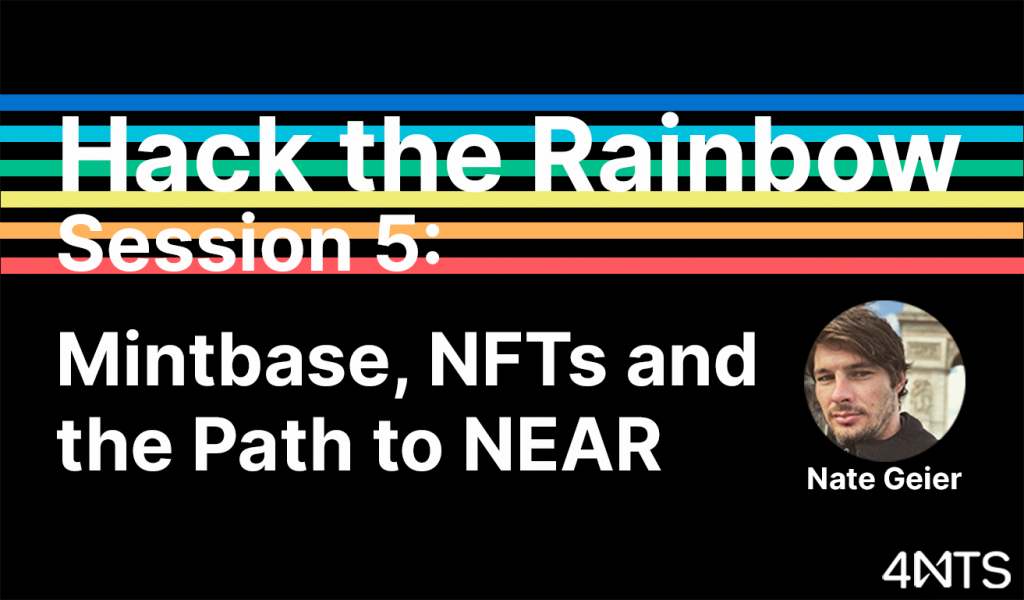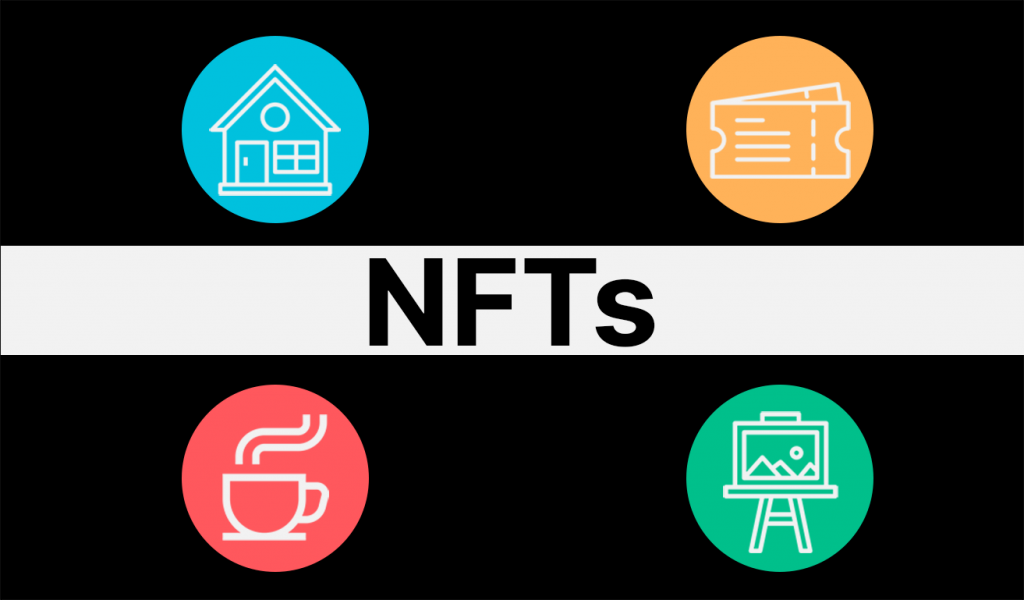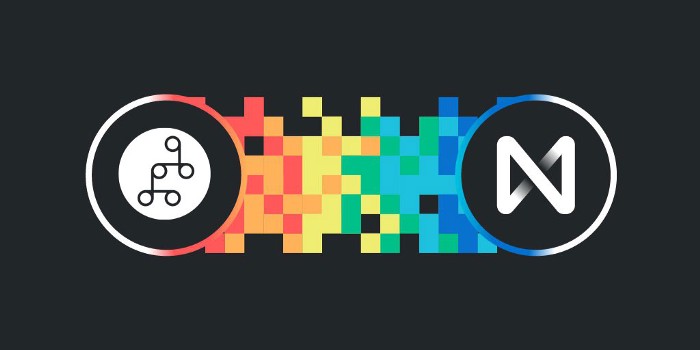Hack the Rainbow Session 5: Mintbase, NFTs and the Path to NEAR with Nate Geier


Session 5 of the NEAR Hack the Rainbow Hackathon featured a high level discussion between NEAR’s NiMA Asghari, and Mintbase CEO Nate Geier. They discuss the development of NFT’s – starting from the basics, and move into different use-cases, the technical design of Mintbase, why Nate chose NEAR, and much more!
For an abbreviated transcript of the notes taken from this session click here.
Point 1: Introducing Non-Fungible Tokens (NFT’s)

At the beginning of the discussion, NiMA and Nate start off by talking a little bit about the history and nature of Non-Fungible Tokens. As Nate explains, the first NFT was created on the Bitcoin blockchain, but the one that made NFT’s go mainstream was CryptoKitties. When discussing NFT’s Nate explains them broadly as ‘anything that is not money tokenized into a single form.’ While the fundamental value proposition of NFT’s is discussed as being based upon demonstrating ownership of a unique object or asset. As Nate Explains:
“Blockchain is getting really excited about two things – it is getting crazy with DeFi, and then NFT’s which is basically everything that is not money tokenized into a single form. Coffee, Artwork, Tickets, anything that is not as fungible of money. For things that have a finite number, or one, it makes more sense to use NFTs. If you want to show ownership for a thing. To show that true ownership of it – which we are seeing in crypto voxels – then that is your property and you can put it on open-sea and set it for auction. That is the microcosm for real property in the future.”
Of particular importance is the wide diversity of applications that Nate envisions NTF’s to have in the future: From Coffee, to Artwork, to Tickets, to property, Non-Fungible tokens are emerging as a new class of digital tokens with serious real world applications.
Point 2: The Origins of Mintbase:
Mintbase was created by Nate Geier shortly after participating in the DevCon4 Hackathon. According to the panel, Mintbase has been named on Dapp Radar as being “One of the largest marketplaces with the most users.” This is because as Nate explains:
“People don’t recognize mintbase as being that massive because you could be using Mintbase without knowing it. A lot of the mint on our platform exist in other spots. Mintbase has over 73,000 transactions through their system.”
Beyond operating as the base layer for minting NFT’s, Nate explains how Mintbase allows each of its Minted NFT’s to also contain music, sound, and legal documents pegged to the NFT in such a manner that it cannot be changed by any party involved in the creation of the NFT itself.
“Music has been the latest thing, a lot of people have been minting music. We enable people to mint multiple files through a single NFT so it’s not just a single part you have in it – it’s your art, and maybe your legal documents are also pegged to it.”
Point 3: Why Nate Chose NEAR:

As the conversation developed, Nate opened up to the community about his decision to move to NEAR. The crucial factor? Gas fees on Ethereum. As Nate explains:
“It is kind of weird having your dreams crushed by Ethereum a little bit. You have this vision, and you know the community and technology pretty intimately and it feels like your best buddy sometimes, and then you spend so much time and effort on a thing that finally got working – building blockchain Apps is super hard. Making it in a way that is a well oiled machine – then seeing gas just skyrocket is a moment of saying – I just spent all that time building an App that might not be that effective. It was a hard last couple of months.”
Upon deciding that he needed to migrate Mintbase off Ethereum Nate describes the process of choosing NEAR, as ultimately being based on coding in Rust on a dynamically sharded blockchain. According to Nate, NEAR’s capacity to scale was one of the key reasons for his choice to build on top of it:
“The benefit of sharding the obvious one is state bloat. Everyone stopped having the conversation that ETH 1 ran into called State bloat. Everyone is just throwing a bunch of stuff into state, and we have to run a node that copies all of that stuff. It’s too big. So eventually machines will not be able to copy all of that stuff into infinity. A lot of applications like xdai will also run into this issue.
To handle this, you either need to get massive machinery like Solana to do all of the copy, while sharding breaks the chain out into a bunch of different areas. So in the future when Mintbase gets massive, parts of one app will be on one shard, and parts will be on another shard. It seems like they handle it pretty relevantly in Rust.”
Point 4: The Future of NFT’s and Industry Disruption
A final point that is both exciting and in the process of being fully developed, is the future of Non-Fungible Tokens in the crypto-sphere and beyond! Nate specifically mentions the applicability of NFT’s to voting and tickets, art, the meta-verse land of crypto, and most interestingly NFT’s for validator node interest:
Nate on Ticketing and NFT’s:
“NFT’s are really going to start shining when using voting and tickets with NFTs. You can buy the ticket using a decentralized currency and go to an event. But as soon as you say there is an open API anyone can interact with to create voting apps or ecosystems, then you can add things by saying, anyone who has a DAppcon ticket can cowork at our space as well – this is really exciting.”
Nate on Art NFT’s:
“Another thing that is pioneering is royalties – we have never been at a time when an artist can sell their art, and continue generating revenue as it moves throughout markets. This is why people are getting excited about Art – we have a programmable piece of item for other things.”
And finally, perhaps one of the most innovative ideas in NFT’s to date: NFT’s for State interest on different networks:
“Mark just minted an NFT that allows you to accrue your states interest, if you are the owner of that NFT. So if you want to give that NFT to your friend for christmas, then they can start accruing the interest. The owner of the NFT is the staker – the Aave staker. The NFT offers portable stake pieces that can be shared or loaned out. DeFi NFT stuff is the next frontier.”
Notes taken from this session can be found here.




